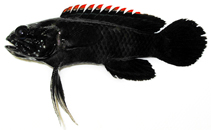| Family: |
Plesiopidae (Roundheads), subfamily: Plesiopinae |
| Max. size: |
10 cm TL (male/unsexed) |
| Environment: |
reef-associated; marine; depth range 1 - 23 m |
| Distribution: |
Indo-Pacific: Red Sea and East Africa to Japan and Oceania. |
| Diagnosis: |
Dorsal spines (total): 10-12; Dorsal soft rays (total): 6-8; Anal spines: 3-3; Anal soft rays: 8-8. Color variable; body generally black or brown; 2 dark stripes behind eye; dorsal spines orange distally; bluish stripe along basal part of dorsal fin (Ref. 5473).
Description: Characterized by having tubed lateral line scales 18-21+7-14; midlateral scales series 22-24; cheek scale rows 3-5 (Ref. 90102). |
| Biology: |
Adults are found under stone or corals in flood basins and lagoons (Ref. 9137). They are common but very secretive and usually found when turning rubble pieces in pools (Ref. 48635). They venture out in the open at night to feed on small crustaceans, fishes and gastropods (Ref. 37816). Eggs are guarded by the male parent (Ref. 205). Minimum depth reported from Ref. 30874. |
| IUCN Red List Status: |
Least Concern (LC); Date assessed: 11 August 2019 Ref. (130435)
|
| Threat to humans: |
harmless |
Source and more info: www.fishbase.org. For personal, classroom, and other internal use only. Not for publication.

